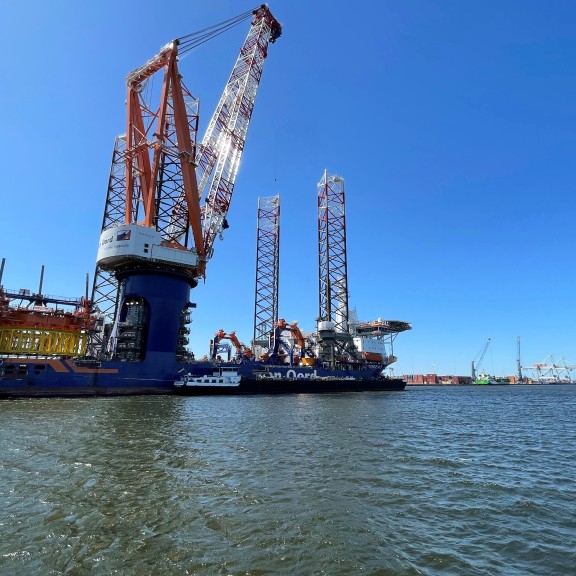
First methanol bunkering in the port of Amsterdam
Last week, the first ship-to-ship methanol bunkering took place in the port of Amsterdam. At the TMA Logistics terminal in the Amerikahaven, the offshore installation vessel Boreas from Van Oord was supplied with 500 tonnes of green methanol, delivered by the bunker vessel Chicago.
The Boreas is a newly built offshore installation vessel and the largest of its kind. In March, the ship entered the Port of Amsterdam for the first time via the IJmuiden sea lock. Last week, a commemorative plaque was presented to the vessel’s captain. The Boreas is the first ship of its kind that can operate on methanol, significantly reducing its ecological footprint. Advanced emission control technologies minimize NOₓ emissions, while a 6,000 kWh battery pack further reduces fuel consumption and emissions. Jaap de Jong, Project Director at Van Oord: “We look forward to deploying this impressive vessel for our offshore wind projects and further advancing the transition to renewable energy.”
Pioneering the Use of Alternative Fuels
A total of 500 tonnes of ISCC-certified green methanol was bunkered via the bunker vessel Chicago from Unibarge. The methanol was supplied by OCI HyFuels. Green methanol is produced using sustainable feedstocks (such as waste and residual streams), resulting in significantly lower emissions of CO₂, particulate matter, and nitrogen. Henri van der Weide, Clean Shipping Advisor at Port of Amsterdam: “We are pleased that Van Oord has chosen methanol. This makes them an important pioneer in the use of sustainable fuels in shipping.”
Multi Fuel Port
Through our Clean Shipping Vision, we aim to become a Multi Fuel Port. To achieve this, we are working on developing safety standards that enable the bunkering of alternative fuels in the Port of Amsterdam. This includes LNG, hydrogen, ammonia, and now methanol. Henri van der Weide: “We do this in collaboration with the Clean Marine Fuels Working Group, a working group within the International Association of Ports and Harbors (IAPH), which focuses on the preconditions ports need to support the energy transition in shipping. Together with this group, we have developed a safety checklist for bunkering operations.”
Safe Bunkering of Alternative Fuels
Alternative fuel bunkering is increasingly common in the port of Amsterdam. Henri: “For example, LNG bunkering has become business as usual for us. Several licensed LNG suppliers are active, and we have created an LNG bunker map based on external safety research, which shows where LNG bunkering can be safely conducted.” Hydrogen has also recently been bunkered in the port. But this was the first time a ship-to-ship green methanol bunkering took place. What is needed to ensure such a bunkering is carried out safely? Henri: “First, a licensed bunker operator who complies with IAPH safety standards. Additionally, we use a methanol bunkering checklist developed with the IAPH. Finally, we as the port authority assess and designate a safe and suitable location or berth for the bunkering.”
By facilitating the use of alternative fuels in shipping in this way, we help our port clients become more sustainable and move ever closer to achieving zero-emission shipping in the port of Amsterdam.